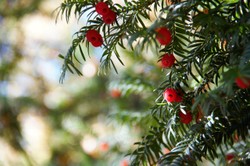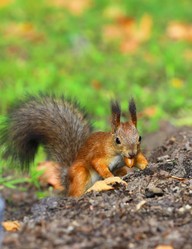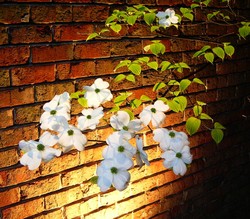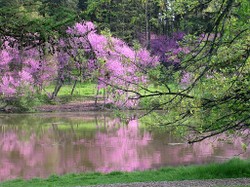Yew trees are native to the British Isles, and though many of us know them as bushy topiary, they can grow into a tree of large size, not in height, but in bulk. They held sacred significance for both our pagan and Christian forebears, and they have been a source of dangerous weaponry and the source of toxins and medications. They are thought to live to a venerable age, though talk of longevity has been challenged.

A Tree Sacred and Deadly
by frankbeswick
Ancient people's regarded yew trees as magical or sacred, but they often used their wood for deadly purposes
A Magical Plant
Long before the first Irish settled the Emerald Isle in the chilly aftermath of the Ice Age Doohoma Forest lined the shore overlooking Achil Island. It was stocked with oak,pine and yew, but it seems to have been part of a massive yew woodland that stretched across County Mayo, a name which comes from Maigh Eo, the Yew Plains. But about seven thousand B.C.. an inundation overwhelmed the edge of the forest, leaving its fossilized remains to be rediscovered in modern times.
Modern Mayo is not nowadays aforested, being farming country, but the memory of the plains rich in yew still lives in the county's crest, which features nine yew trees, one for each of the nine baronies in Mayo. There is also some good planting at.the historic ruins of Cong Abbey, where a number of yews have .graced the grounds for about two hundred and fifty years. Ireland gave rise to a distinct subspecies of yew Whereas yew is classified as Taxus baccata, Irish yew is Taxus baccata "fastigiata." The speech marks denote that it is a subspecies artificially propagated by vegetative propagation, which means that it is propagated by cuttings. This is because it hardly produces any male flowers so cannot be relied on to securely reproduce. It is a relatively new mutation only discovered in County Fermanagh in the eighteenth century.
But yews are not restricted to Ireland, They strew the British Isles in large numbers. In the millennium before 2000 B.C the hill called Caburn, which is a relatively high outlier of the South Downs, a range of hills adorning the South Coast of England, It was surrounded by archaeological sites evidencing human settlement, but according to palaeobotanical investigations, the hill crown was uninhabited and covered with a dark woodland. It seems to be a place deemed sacred or magical. But the ancient Britons were not averse to using yew wood, for their priests, the druids, used yew wood to make wands or magician's staffs. As druidry was spread across Britain, Ireland and Gaul, this magical use of the yew tree would have been widespread. The druids had an alphabet known as ogham, which was based on trees, and this alphabet had the symbol for yew as its final letter, and the tree denoted immortality . Yew was therefore a sacred tree.
The English respected the yew, for it is said that King John signed the Magna Carta under the shade of the Ankerwycke yew at the side of the Thames, a site that had been used by the Saxon king Alfred, the only English monarch to be honoured with the adjective great, which indicates its significance
A Long Lived Plant.
Scholars argue about yew's longevity. In the 1980s a visionary called Allan Meredith had a series of dreams that convinced him that yews were ancient and sacred and he devised a method of dating them which seemed to work. Soon it came to be thought that yews were very ancient indeed, possibly reaching several thousand years old. This gave rise to the belief that the well-established Anglo-Saxon custom of planting yew trees in church yards was rooted in a pre-Christian custom of planting trees symbolic of longevity and immortality in those precincts. The belief that these ancient churchyards were pagan sacred precincts already planted with yew arose, and this fostered claims of great longevity for the yew. However, Professor Ronald Hutton writing in Pagan Britain points out that research by Jeremy Harte has revealed that yews are greatly varied in their growth rates so their ages are hard to calculate with accuracy. You certainly do not want to cut down an ancient yew to count its rings.
However, while some of the calculated ages may be dubious, there seems to be a general awareness that yews are long-lived. It may be the case that the Christians planted them as signs of immortality. Hutton points out that Christian clerics often came from a European background, and that in European cultures evergreen trees, as the yew is, were symbolic of immortality, and so they would be the symbols which would come naturally to the priests. Moreover, the Druids' Ogham alphabet, which was based on trees, used the yew as a sign of immortality. The yew was certainly not as sacred to the Druids as were the oak and the sweet apple, but it certainly had sacred significance. It seems to me that there was folklore that yew trees were long-lived, but it is a justified belief that needs some scientific support.
The yew's longevity may be partly due to its growth rate. We notice that yew is useful in topiary, and often it seems to be more of a rapidly growing shrub rather than a tree. A yew hedge is easy to grow and maintain. But its early growth rate cannot be maintained, and it slows down. After about 400 years its growth rate becomes very much slower, and after a thousand its pace of growth is very slow indeed. But it does not seem to be prone to dying off, and yew trees tend to die either by storm damage or by felling. But even when they are chopped down the remaining stump sprouts out new coppiced growth. Yews also send out suckers and so clone themselves, a fact that makes estimating a yew's true age very difficult, and even if the parent tree dies, the offspring are still thriving. In their natural state the suckers may spring up from the parent plant, and become so entwined with it that it is hard to determine which is sucker and which is parent.
It has the ability to withstand quite a lot of wind damage, for even when the heartwood of an ancient yew is rotted by fungal infection, the sapwood can sustain the tree and there are gnarled old yews with hollowed out hearts that have survived for years still clinging to life. This durability adds to the argument that the yew is long-lived. Put simply, you survive when you are hard to kill.
Uses of Yew
The wood of the yew tree has a great strength and was used to make weapons. On the fast eroding South East coast of Britain prehistoric remains are often washed up or revealed as an eroding bed of clay is revealed. On the beach near the Essex town of Clacton archeologists discovered a yew spear 420,000 years old, made by pre-Homo Sapiens hominids millennia ago. There have been several instances of ancient longbows made of yew wood found preserved in peat deposits in various parts of Britain, and this is due to the peculiar character of yew wood. As an evergreen it is a softwood, but it is the hardest of softwoods, and it is particularly springy. Bend it, and it tends to recover its shape. This durable springiness makes it suitable for bows. It was used to deadly effect in the hundred years war by the English archers against the might of France. The drawing power of a longbow was enormous, it could send an arrow that would penetrate a suit of armour at a few hundred yards. Longbows made of yew were found on the submerged wreck of the Mary Rose.
You have heard of the mediaeval term yeoman, a word that denotes a strong, sturdy and reliable fighting Englishman, well a yeoman was a yew man, a man who was strong enough to handle a longbow and skilled at its use. Such men were trained from childhood to handle this difficult to draw weapon.
Besides its capacity to make murderous weapons it has the distinction that every part of it is poisonous to humans. Quite possibly the word toxic derives from yew wood, the Latin for yew being taxus. The small red fruits, known as arils, contain a poison that can be fatal to the heart. It is really the seeds that are poisonous. These fruits resemble berries, but are in reality a modified cone, for yew is actually a conifer. Birds can eat these fruits as the seeds pass through them undigested. But like all or most poisons the toxin can serve as a medicine for heart problems in the hands of a suitably qualified doctor or herbalist.
The wood of the yew has a straight grain and is ideal for woodwork, and it is easily worked, which is a boon when a craftsperson is turning a small item. The quality of the wood makes it suitable for cabinet making, and for high quality furniture. It is also able to be used in the making of musical instruments.
A sturdy tree,and a great asset to the British landscape.
I am an Amazon associate and earn money by qualifying purchases on this page.
You might also like
The British OakOak trees are inextricably linked with Britishness, for if there is a nationa...
Flowering Dogwood (Cornus florida): Spring's Early Pink, Red, ...Flowering dogwood (Cornus florida), a New World native flowering tree, glorio...
Eastern Redbud: Spring's Early Pleasing Pastel of Magenta PinkNew World native Eastern redbud is one of the first trees to flower in spring.








 Pilgrimage. A reviewon 06/15/2025
Pilgrimage. A reviewon 06/15/2025
 Leo the Fourteenthon 05/09/2025
Leo the Fourteenthon 05/09/2025
 The Melsonby Hoardon 03/25/2025
The Melsonby Hoardon 03/25/2025




Comments
We know the saying.
Thank you!
What I was finding elsewhere, unlike your clear, helpful, succinct explanation below, was as clear as mud.
Would you eastern-ponders have the above saying, that something is "clear as mud" -- ;-D -- to refer to murky statements and thoughts?
The narrows probably refers to the fact that the lough is in fact two laughs linked by a narrow, shallow passage.
The second paragraph under your first subheading, A Magical Plant, alludes to Cong Abbey.
Online sources correlate cong with the Irish word conga for "narrows." They describe those narrows as the narrow part of a navigable waterway.
That seems a bit vague. How would one specify then which of possibly a number of narrow parts of a waterway one would mean?
Would you know of another term (online sources are just affirming one another with the above definition)?
It sounds realistic, but we have no sources independent of the one cited here, so we cannot know for certain.
The first paragraph under your third subheading, Uses of yew, caused, with its reference to longbows, me to ponder something I read in a historical fiction book about King Richard I.
King Richard is presented as dying from a shoulder wound from a crossbow bolt. He is shown as forgiving the archer, whose skill he admired on the Châlus-Chabrol battlements, even as that mercy was not respected with his death almost 2 weeks later, when the young archer was executed in hot boiling oils.
Would that be an accurate, or completely fanciful, version regarding the last days of King Richard I?
I don't think the guitar players are playing pre modern music. But I have no expertise with musical instruments. My fingers are not sufficiently dexterous to handle an instrument. But
I could always sing.
My point is that just because you might get away with eating arils, minus their seeds, it is safer not to.My second son, an ardent foody and a classy cook, has a saying,, "just because you can eat something it does not mean that you have to."
The next-to-last sentence in your last subheading, Uses of yew, considers that "The wood of the yew has a straight grain and is ideal for woodwork, and it is easily worked, which is a boon when a craftsperson is turning a small item. The quality of the wood makes it suitable for cabinet making, and for high quality furniture. It is also able to be used in the making of musical instruments."
Online sources identify yew wood as usable by lute players more than by guitar players in the British Isles.
Is it possible that those guitar players are performers of pre-modern music? (I wonder about this possibility because of yew use for lutes.)
Thank you!
What you explain fits with what I always have understood. So it's surprising, and a bit unsettling, to see online sources presenting themselves credibly and saying otherwise.
It therefore will be fresh salads -- without yew arils -- with wild brambleberries, strawberries and wineberries in June, when the first- and second-mentioned fruits move from their present flowering to their next-month fruiting stages.